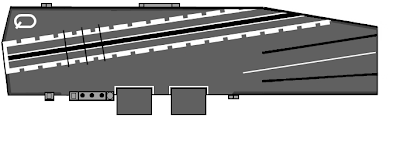The procurement of a 35,000 to 40,000 ton design with aircraft lifts forward of the superstructure, to enable simultaneous launching and recovery of aircraft (the same concept as the new Gerald F. Ford Class), is the most ergonomic option:
 [This design is heavily modified from a Grand Logistics blog page. Note: the bridge is on the starboard side, unlike in the G.L. linked article, because pilots aborting their landings tend to pull away to the left.]
[This design is heavily modified from a Grand Logistics blog page. Note: the bridge is on the starboard side, unlike in the G.L. linked article, because pilots aborting their landings tend to pull away to the left.]The main structural features of this vessel should include a flared (boxy) hull, like the Italian MMS Cavour aircraft carrier, to increase hangar space, and a port side sponson to increase angled flight-deck space. The catapult system should use the Electromagnetic Aircraft Launch System (EMALS).
The ship's aft section should include bays, one on each side, that can be utilised for landing craft, as seen with HMS Ocean, so that the vessel can also act as a LPH. The design must include two loading ramps allowing the ship a Roll-on Roll-off capability - with one large ramp at the stern and a starboard side ramp under the superstructure.
The weapons systems of this vessel, excluding aircraft, must feature CIWS, anti-air and anti-ship VLS missiles with a mind to include torpedo/sonar systems allowing increased ASW capability in high threat environments.
Aircraft carried include the following:
(14) FJ-23 or F/A-XX Multi-Role Fighters -- with 8 shore based.

(2) EA-6B Prowlers or (3) 'EFJ-23/EA-XX' electronic warfare aircraft -- with 2 shore based
(2) E-2D Hawkeye AWACs platforms -- with 2 shore based.
(4-8) UAV/AEW tiltrotor drones or airship drones.
(3) S-3 Vikings ASW/tankers/SAR (new built) -- with 3 shore based.
(6) SH-60R ASW helos or AW101s.
(2) AS565 MB Panther helos.
Two shore based training squadrons will feature:
(14) T-45 Goshawks -- upgraded and equipped to carry a greater range of ordinance and sensors on their 3 underwing hardpoints. Notable weapons include anti-ship missiles, air-to-ground missiles, anti-radar missiles, AAMs, JDAMs and laser guided bombs.

(14) Embraer EMB 314 Super Tucanos -- navalised and equipped with tail hooks. The numbers of NAVY Tucanos will be in addition to the total Air Force numbers (65).
Both the Goshawks and Super Tucanos will be embarked intermittently during training exercises AND potentially during combat operations, with up to four (4+) used primarily in the close-air-support role.
The Two Aircraft Carrier Option:
In the (unlikely) event two Aircraft Carriers can be purchased, one can be used as an LPH or Ro-Ro transport and rapidly re-equipped with fixed wing aircraft during an emergency. The aircraft for this second carrier would be shore based and rotate aboard the active strike carrier under normal circumstances. When configured as an LPH the ship could also be used as a dedicated anti-submarine warfare vessel perhaps also operating S-3 Vikings.
In the event of having two aircraft carriers the following should occur:
1. The number of aircraft available for ship-based operations must be doubled, leaving the shore based numbers the same. This means there will be a total of 36 FJ-23 or F/A-XXs operated by the NAVY. This is 14 per ship with 8 shore based.
2. Training squadrons will each have an additional 2 aircraft - making 16 aircraft per squadron.
3. The addition of two (2) Hobart Class Destroyers (or equivalent vessels) - making the total 5.
4. The addition of two (2) Type 26 Frigates - making the total 14.
5. The addition of one (1) Fleet Replenishment vessel - making the total 3.
Please note: All dedicated fixed wing aircraft carriers must be Catapult designs that allow a much larger range of aircraft types. Such ships can operate US and French warplanes including fixed wing AWACs aircraft such as the E-2D Hawkeye. This is in contrast to the helos, tiltrotors, and ONE type of VSTOL fighter available to VSTOL designed carriers.
Australia must never follow the UK model where they have built two giant 65,000 ton flat tops and NOT put in catapult systems! A smaller CATOBAR designed ship versus these larger vessels would have a distinct advantage in being able to fly longer range fighters and dedicated surveillance aircraft.
